Related Research Articles

Infante Juan of Spain, Count of Barcelona, also known as Don Juan, was the third son and designated heir of King Alfonso XIII of Spain and Victoria Eugenie of Battenberg. His father was replaced by the Second Spanish Republic, and under his son, Juan Carlos I, a constitutional monarchy was installed.

Comillas Pontifical University is a private Catholic higher education institution run by the Spanish Province of the Society of Jesus in Madrid Spain.
San Ildefonso or just Ildefonso, is a masculine name, originally from the Gothic language. It is taken from the name Hildefuns meaning "battle ready". It is Latinised as Ildephonsus, and it is possible that Alfonso is a variant of this name.
Education in Spain is regulated by the Ley Orgánica 8/2013, de 9 de diciembre, para la mejora de la calidad educativa that expands upon Article 27 of the Spanish Constitution of 1978. The Spanish education system is compulsory and free for all children aged between 6 and 16 years and is supported by the national government together with the governments of each of the country's 17 autonomous communities.
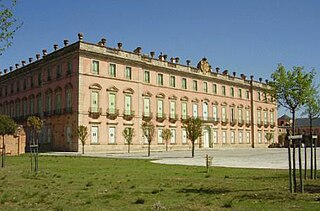
The Royal Palace of Riofrío is one of the residences of Spain's royal family and under the management of the Patrimonio Nacional, a government initiative dedicated to the care and maintenance of properties owned by the Spanish state which are used by the royal family. Situated in the municipality of San Ildefonso, in the province of Segovia, central Spain, the building is set in a wooded deer-park.

The Royal Palace of La Granja de San Ildefonso, known as La Granja, is an early 18th-century palace in the small town of San Ildefonso, located in the hills near Segovia and 80 kilometres (50 mi) north of Madrid, within the Province of Segovia in central Spain.

Saint Ildefonsus or Ildephonsus was a scholar and theologian who served as the metropolitan Bishop of Toledo for the last decade of his life. His Gothic name was Hildefuns. In the Ethiopian Orthodox Tewahedo Church he is known as Saint Dexius based on the Ge'ez translation of the legends about his life.

Colegio Imperial de Madrid nowadays Instituto San Isidro, was the name of a Jesuit educational institution in Madrid (Spain).
The Spanish Christmas Lottery is a special draw of the Lotería Nacional, the weekly national lottery run by Spain's state-owned Loterías y Apuestas del Estado. The special Christmas draw takes place every December 22 and it is the biggest and most popular draw of the year.

Rubí is a municipality in Catalonia (Spain), in the comarca of Vallès Occidental and the province of Barcelona, 15 kilometers from Barcelona. It is bordered on the north by Terrassa and Ullastrell, on the south by Sant Cugat del Vallès, on the west by Castellbisbal and on the east by Sant Quirze del Vallès.
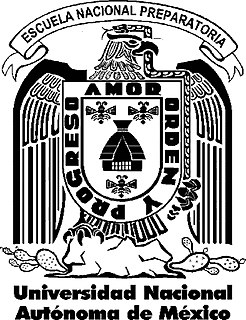
The Escuela Nacional Preparatoria (ENP), the oldest senior High School system in Mexico, belonging to the National Autonomous University of Mexico (UNAM), opened its doors on February 1, 1868. It was founded by Gabino Barreda, M.D., following orders of then President of Mexico Benito Juárez. It is also modern UNAM's oldest institution.

Nuevo Baztán is a municipality southeast of Madrid, near Alcalá de Henares, Spain. It consists of a small historic centre and modern housing estates.
Mercedes de Jesús Egido y Izquierdo, was a Spanish Roman Catholic nun of the Order of the Immaculate Conception who undertook a major reform of the Order's way of life. The cause for her beatification is being investigated by the Holy See.

During the Spanish colonial period in the Philippines (1521–1898), the different cultures of the archipelago experienced a gradual unification from a variety of native Asian and Islamic customs and traditions, including animist religious practices, to what is known today as Filipino culture, a unique hybrid of Southeast Asian and Western culture, namely Spanish, including the Spanish language and the Catholic faith.
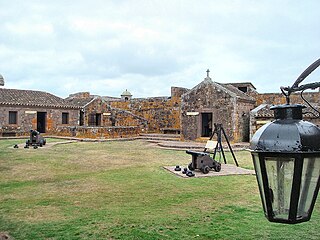
Fuerte de San Miguel is a military fortification in the small town of Dieciocho de Julio in the Rocha Department of eastern Uruguay. It was erected in 1737 by the Portuguese, having abandoned the attempt at building a fort in Maldonado. It was constructed of large, heavy stones to create the tall towers, thick walls and sturdy ramparts to withstand the onslaught of wars fought against the Spanish invaders which was instrumental in Uruguay evolving as an independent nation.
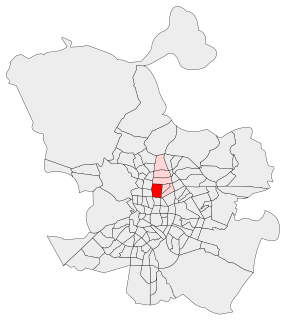
El Viso is a neighborhood of Madrid, part of the Chamartín District. Consisting mainly of residential detached houses, it is currently the wealthiest neighborhood of the Spanish capital, overtaking the Salamanca District. Aristocrats, businessmen, politicians and diplomats have inhabited this area for half a century. The neighborhood also hosts the main headquarters of the Spanish National Research Council (CSIC).

The Instituto de Enseñanza Secundaria San Isidro is a co-educational day school for pupils from 12 to 18 years of age. It is located in the historical Calle de Toledo in Madrid, Spain.

The Church of San Ildefonso is a Baroque style church located in the historic center of the city of Toledo, in Castile-La Mancha, Spain. It is also known as the Jesuit church and is consecrated to Saint Ildefonso of Toledo, patron of the city and Father of the Church.
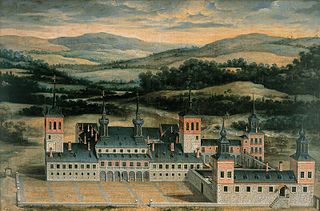
The Royal Palace of Valsain is a former Spanish royal residence, which is now in ruins. It is located in Valsain in the Province of Segovia, in the Castile and León Autonomous region of central Spain. It is approximately 14 kilometres (8.7 mi) from Segovia, and 75 kilometres (47 mi) north of Madrid.
Fernando Visier Segovia is a Spanish chess player with the rank of FIDE Master. He won the Spanish Chess Championship twice.
References
- ↑ Colegio de Educación Infantil y Primaria (college of early childhood and primary education) Anexo:Siglas y acrónimos, es.wikipedia.org, retrieved January 14, 2012
- ↑ "Dat Madrid Capital". Archived from the original on January 18, 2008. Retrieved September 26, 2007.
Coordinates: 40°24′46″N3°42′44″W / 40.4129°N 3.7122°W